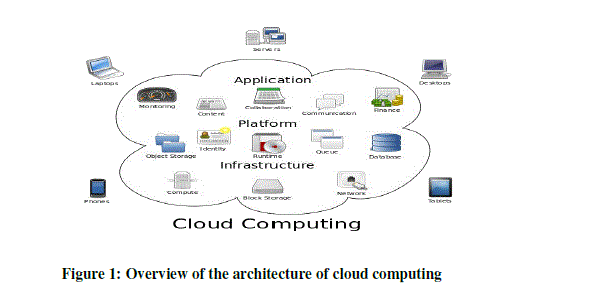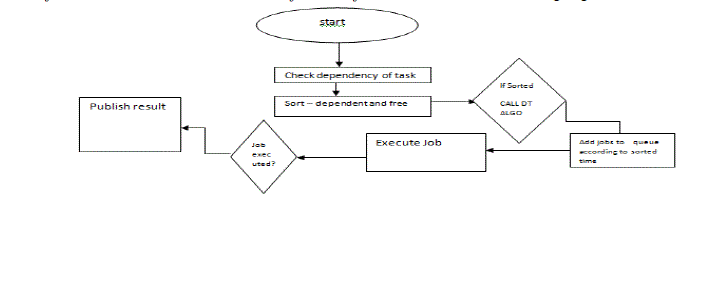Keywords
|
| Cloud Computing , Grid Computing , Scheduler , Scheduling Algorithms , FCFS , Round Robin |
INTRODUCTION
|
| A) Cloud Computing: Cloud Computing is the evolving paradigm with changing their definitions but in this research project, it is defined in the term of a virtual infrastructure which can be provides the shared information and services of communication technology, via the internet “Cloud” for access of “external multiple users” through use of the Internet or the “large-scale private networks”. Cloud Computing is providing a computer user access to the Information Technology services i.e., data servers ,storage, applications, without requiring understanding of a technology or even the ownership of infrastructure. To comprehend the Cloud Computing, an analogy to electricity computing grid is to be useful. According to [1] and other similar reviews and also recommended by most of the cloud computing service providers(Google , Microsoft , IBM etc ) the cloud platform is consisted of three major factors. |
| IAAS (Infrastructure as a Service ) |
| PAAS (Platform as a Service ) |
| SAAS (Software as a Service ) |
| As if for the now the cloud is able to cope up with all the existing environments as mentioned in [1] and [2] it would be interesting to see how the grid computing environment works in there. |
| B)Grid Computing : Grid environment is a dynamic, heterogeneous[3] and unpredictable computing system which shares different services among various users. Because of heterogenous and dynamic nature of the grid, the methods used in traditional systems could not be applied to grid scheduling. Hence with the above statement we considerably come to know that Grid computing is a sophisticated approach of scheduling the tasks. Now as a matter of fact we should look at the existing working models of the scheduling environment . |
EXISTING SCHEDULING ALGORITHMS
|
| A)FCFS : FCFS stands for ” First Come First Serve “. This algorithm has a simple policy of completing those task first which reaches to the server first ignoring the priority of the job or the time limit. FCFS has been already implemented to both the grid and cloud environment. |
| B)Round Robin Algorithm : In the round robin scheduling, processes are dispatched in a FIFO manner but are given a limited amount of CPU time called a time-slice or a quantum [4]. If a process does not complete before its CPU-time expires, the CPU is preempted and given to the next process waiting in a queue. The preempted process is then placed at the back of the ready list. There are lots of other scheduling algorithms also based on the research models . Enhancing the current scenario our proposed model goes as follows . |
| C)Priority scheduling algorithm: |
| The basic idea is straightforward: each process is assigned a priority, and priority is allowed to run. Equal-Priority processes are scheduled in FCFS order. The shortest-Job-First (SJF) algorithm is a special case of general priority scheduling algorithm. An SJF algorithm is simply a priority algorithm where the priority is the inverse of the (predicted) next CPU burst[5]. That is, the longer the CPU burst, the lower the priority and vice versa. Priority can be defined either internally or externally. Internally defined priorities use some measurable quantities or qualities to compute priority of a process. |
| D)Hybrid Algorithm (FCFS + Priority ): Scheduler executes the jobs, if the job is dependent on another job, then the job scheduler will check the priority of the dependent job[6], if the dependent job has higher priority then it will be executed. |
| But if the job is dependent on more than one job and the priority of the jobs are same then according to FCFS scheduling algorithm the job which comes first will be executed first. |
| E)Critical Path Algorithm: This algorithm divides the entire tasks into two parts [7], first category refers to those tasks who also consists of subtasks and other are task independent tasks. This particular algorithm is almost similar to the algorithm discussed in [6]. |
| Based on the above studied algorithm , our proposed algorithm is as follows . |
PROPOSED ALGORITHM
|
| Our proposed algorithm is a combination of Critical Path Algorithm [7] and Decreasing Time Algorithm. The decreasing time algorithm is a like priority algorithm and it sorts the jobs according to the shortest time first and rest accordingly in ascending order. |
| There would be two benefits of this combination. |
| a)Jobs would be sorted according to the dependent tasks and the Priority would be assigned accordingly. |
| b)Decreasing Time algorithm would make the above architecture more accurate as it would sort the above already sorted jobs in a manner such that out of sorted jobs , that job would execute first which is going to consume the least time. |
CONCLUSION
|
| With all the context gone through, we can conclude that there are several efficient algorithms of scheduling both at cloud and grid computing network. Each algorithm is sufficient enough to compute effective results in their corresponding comfort zone but when the algorithms are put into a situation which is sophisticated , the outcome is not as expected . Our designed algorithm is expected to full fill the needs of modern computing of cloud and grid and the proposed algorithm is expected to produce effective results in different kind of scenarios also . |
Figures at a glance
|
 |
 |
| Figure 1 |
Figure 2 |
|
References
|
- Boutaba, Q. Z.”Cloud computing: state-of-the-art and research challenges.” J Internet Server App ,VOL 1 pp-21-34, 2012.
- Paul T. Jaeger, J. L.”Cloud Computing and Information Policy: Computing in a Policy Cloud”Journal of Information Technology &Politics ,Vol 17. 2008
- SarathChandar A P, Priyesh V, Doreen Hephzibah Miriam D “Grid Scheduling using Improved Particle Swarm Optimization with Digital Pheromones“ International Journal of Scientific & Engineering Research, Volume 3, Issue 6, June-2012 1 ISSN 2229-5518
- Pinal Salot“ A SURVEY OF VARIOUS SCHEDULING ALGORITHM IN CLOUD COMPUTING ENVIRONMENT “ VOL 1 IJRET | FEB 2013,Available @ http://www.ijret.org/
- ShalmaliAmbike, DiptiBhansali, JaeeKshirsagar, JuhiBansiwal “ An Optimistic Differentiated Job Scheduling System for Cloud Computing”International Journal of Engineering Research and Applications (IJERA) ISSN: 2248-9622 www.ijera.com Vol. 2, Issue 2,Mar-Apr 2012, pp.1212-1214
- AmandeepKaurSidhu, SupriyaKinger“A Sophisticated Approach for Job Scheduling in Cloud Server” International Journal of Computer Trends and Technology (IJCTT) – volume 4 Issue 7–July 2013
- Tianchi Ma and RajkumarBuyya” Critical-Path and Priority based Algorithms for Scheduling Workflows with Parameter Sweep Tasks on Global Grids “ The University of Melbourne, Australia VOL 1 2012
|